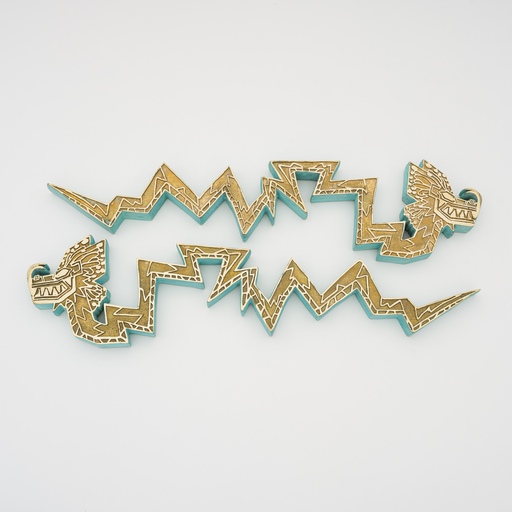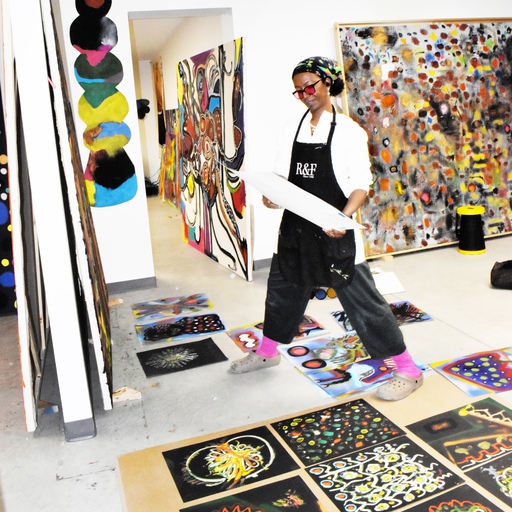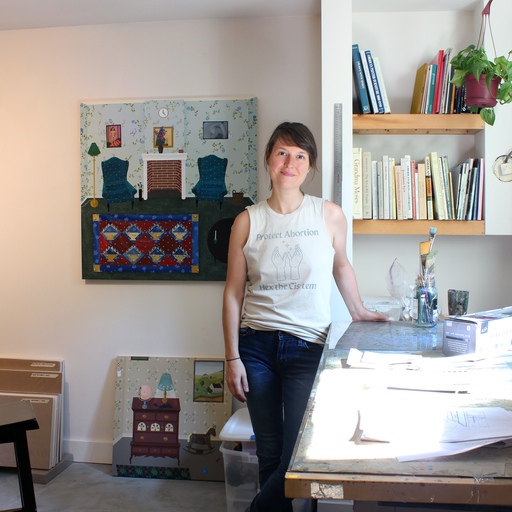“A lot of significant experiences happen in quiet moments. There are entire worlds in subtle saturation or value shifts,” Florida born, Brooklyn-based artist Anthony Cudahy told Wallpaper* magazine recently. “Usually, I know a painting is working if it's both very specific to me and open enough to be generative for others.”
In 2023, Cudahy (pronounced ’kud-da-hay’) painted a diptych called Violent echo/Rumination. The first picture in the series – a roiling, oil, acrylic, and pencil on canvas work – showed an orangey-red suburban scene, a response to apocalyptic smoke clouds that had drifted down from Canada and engulfed New York that June.
The second image, – a sedate, oil on linen painting of a man seated at a table – was more measured, though also shot through with a sense of disquiet. “Next to him rests an iPhone,” writes the curator Devon Zimmerman in the artist’s new Monacelli Press monograph, Anthony Cudahy: Spinneret, “seemingly just used to ‘doom scroll’ through the endless snippets of news and information about the catastrophe.”
It’s an apt example of the kind of art Cudahy favors. Born in Florida in 1989, the artist came of age in the era of LiveJournal, Facebook and early Instagram; he took his BFA at the Pratt Institute in 2011, received his MFA from Hunter College in 2020, and managed to develop his own, truly distinctive style of permanent image making in the age of the ever-scrolling screen.
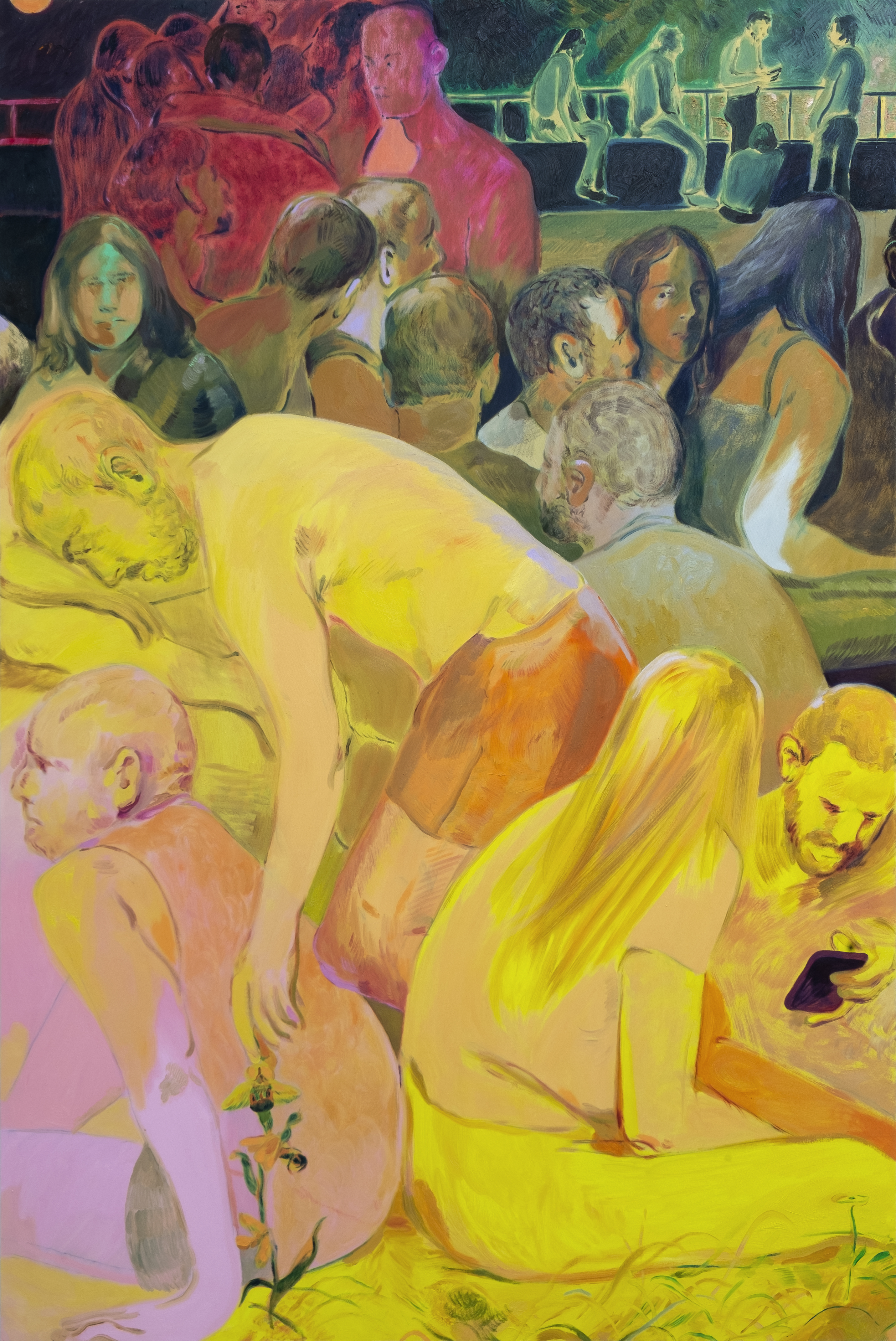 Crowd (Day and Night) 2020 Oil on canvas 72 x 48 in Inam Malik Image Credit:Courtesy of Artist and 1969 Gallery.
Crowd (Day and Night) 2020 Oil on canvas 72 x 48 in Inam Malik Image Credit:Courtesy of Artist and 1969 Gallery.
“When I first started painting, I was thinking about the role of a painter as this collector of images, almost like you’re a Tumblr,” he told the New York Times.
Those images include intimate snaps of Cudahy’s husband, the photographer Ian Lewandowski, snippets of great works from the high points of art history going back to the middle ages; family photos, pictures from gay and lesbian archives, as well as pieces of print ephemera (in addition to being a painter, Cudahy occasionally makes fanzines).
While the paraphernalia of modern life from which the artist draws could be seen as essentially ephemeral or singular, the feelings and recollections he manages to instil are truly universal. There’s often a stillness to his paintings that evokes the inner lives of the characters depicted.
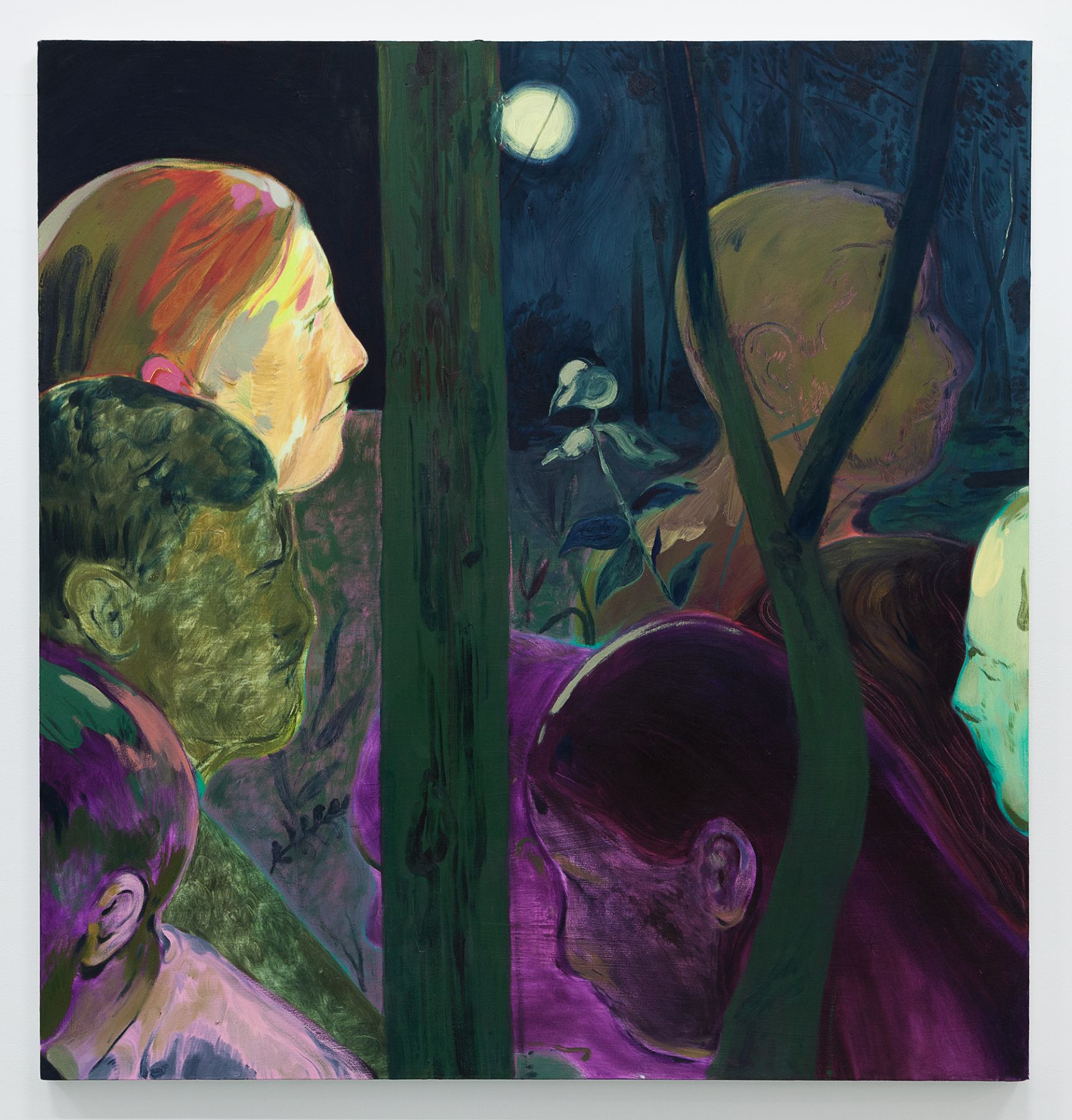 Circle Game 2019 Oil on canvas 50 x 48 inches Weissman Family Collection Image Credit: Courtesy of Artist and 1969 Gallery
Circle Game 2019 Oil on canvas 50 x 48 inches Weissman Family Collection Image Credit: Courtesy of Artist and 1969 Gallery
Some of this comes from Cudahy’s unique source materials. “I have assembled my own archive over the years, collecting images and looking at them and reusing them over a decade now,” the artist explained in 2020. “These are from all over the place. From paintings throughout history, to screenshots on the internet, from news images to vernacular photography. There’s a spark, or a moment of an image gives me a color idea, or a mood I want to explore. The quiet process of going down rabbit holes is a piece of my overall practice.”
That moody response is recognised by fellow painter, Justin Liam O’Brien, who writes in Anthony Cudahy: Spinneret: “Cudahy understands what memory looks like or, perhaps, what memory feels like. And he knows how to paint it.”
Part of Cudahy’s technique lies in the way his images constantly refer back to one another. “To paint is to have that conversation with other paintings,” the artist told Frieze in 2023, “and eventually with your own body of work. My work feels like a living history – a collaborative process unto itself.”

Sunset 2020 Oil on canvas 48 x 36 inches Elio Artese Courtesy the artist and Deli Gallery, New York. Photographed by Max Marshall.
In August last year (2023), Cudahy described just a few of the inspirational pieces taped up in his studio in a Bomb magazine interview. “On the bottom right is this beautiful Albrecht Dürer still life,” he said. “I’ve probably painted that plant into ten to fifteen paintings. Other wall pieces are more utilitarian, and some are just, like, good studio feelings. Some are from when I was a teenager that I’ve always kept with me. I’m very drawn to medieval and Byzantine imagery. Some are from Butt magazine; they did a calendar in 2014. It kind of runs the gamut. I love Pieter Bruegel so much. He’s always here.”
The distinction between high and low-brow imagery used to concern him more than it perhaps does today. His mother was a painter, and Cudahy initially studied painting at Pratt, but switched to communications design, as he felt that course afforded better employment opportunities.
“I found the most ideal day job as a graphic designer, which I worked at for almost a decade,” he told Bomb magazine. “And that actually really kept me painting. It was a level of stability. Right when I graduated, I already had all this baggage; I felt I wasn’t a serious painter because I didn’t actually study painting.”
In response, Cudahy vowed to focus more on the gravitas present in his work. “I was trying to make work more serious or somber—deadening the colors a little bit—so that it was more like Luc Tuymans.”

Lily and mirror with Apocalypse Tapestry 2022 Oil on linen 72 x 72 in Aleksandra Janke and Andrew McCormack Image Credit: Courtesy of the Artist and GRIMM, Amsterdam | London | New York. Photographed by Lance Brewer.
He has since adopted a different attitude towards pigmentation. “I now understand color as a force or a personality,” he told Cultured magazine in 2022. “It’s sort of a character in the paintings and its function is narrative.”
The shift took place during his Masters course. “Eventually, I found my way to the Hunter College grad program, and I did my MFA in painting. It really loosened up a lot of my inhibitions, and I became a lot less afraid to be romantic with the colors and images. That also lined up with the art world being interested in figurative work again.”
Cudahy's paintings hang beautifully alongside many other stars of the recent rise in queer figurative painting, such as Nicole Eisenman, Salman Toor, Doron Langberg, and Louis Fratino. He has enjoyed a number of well-received solo exhibitions, and his work appears in prominent, permanent collections across the globe, including those belonging to the Baltimore Museum of Art, The Hort Family Collection; the USA Institute of Contemporary Art, Miami; the Kunstmuseum, in The Hague; and the Xiao Museum of Contemporary Art, in Rizhao, China.

Vivien with the Net 2020 Acrylic on canvas 24 x 18 in John Friedman / Easton Capital Collection Image Credit: Courtesy of artist and 1969 Gallery
However, the paintings aren’t simply pretty pieces of wall jewelry, but instead have a restless, unplaceable quality, which makes categorization difficult.
When he views other works from the new figurative boom, the artist says, he asks himself "where’s the death?" In his own work, the shadow of death is ever-present. “It’s been part of the whole bundle for me, of thinking and trying to exist,” he explains.
This doesn’t make his paintings overly morbid; instead, it instills them with an existential depth. In this artist’s hands, a long-forgotten corner of a Renaissance canvas, or a discarded holiday photograph is reborn, and freighted with meaning.
 Lily and snake bundle (“And she took the time to believe in what she said and”) 2021 Oil on canvas 96 x 72 in Simon Nixon Family Image Credit: Courtesy the artist and Hales, London and New York. Photo by JSP Art Photography.
Lily and snake bundle (“And she took the time to believe in what she said and”) 2021 Oil on canvas 96 x 72 in Simon Nixon Family Image Credit: Courtesy the artist and Hales, London and New York. Photo by JSP Art Photography.
One of his most celebrated paintings, Arthur Russell on the Shore, from 2023, is a depiction of Russell – a 20th century queer experimental musician – based on a photograph taken by the musician’s father. It’s a vivid, luminous rendering of Russell, who died in 1992; he’s bare-chested and focussed, with his hands on his cello and one foot in the ocean.
“I wanted to create a moment of aliveness and electricity in the stream, and it made sense for the contact to be directly with his skin,” the artist explained to Frieze. “It’s a stark contrast to the rest of the painting which is imbued with cooler tones; his ghostly figure is constantly disappearing and reappearing.” There’s an entire world there, in that one quiet moment.
If you'd like to learn more about the work of Anthony Cudahy get a copy of the Monacelli Press book, Anthony Cudahy: Spinneret at Phaidon.com.

Waiting 2019 Oil on canvas 54 x 24 in Simon Nixon Family Image Credit:Courtesy the artist and Hales, London and New York. Photo by JSP Art Photography.
 People Spiral 2020 Oil on canvas 40 x 30 inches Tiffany Rafii Image Credit: Courtesy of Artist and 1969 Gallery.
People Spiral 2020 Oil on canvas 40 x 30 inches Tiffany Rafii Image Credit: Courtesy of Artist and 1969 Gallery.

















